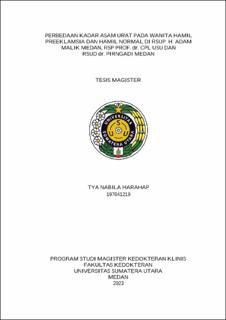Perbedaan Kadar Asam Urat pada Wanita Hamil Preeklamsia dan Hamil Normal di RSUP. H Adam Malik Medan, RSP PROF. dr. CPL USU dan RSUD dr. Pirngadi Medan
Differences of Uric Acid Levels in Preeclamptic and Normal Pregnant Women in Rsup. H Adam Malik Medan, RSP. PROF. dr. CPL And RSUD dr. Pirngadi Medan

Date
2023Author
Harahap, Tya Nabila
Advisor(s)
Lintang, Letta Sari
Rusda, Muhammad
Metadata
Show full item recordAbstract
Background: Preeclampsia, characterized by hypertension and proteinuria, is a multisystemic disorder that occurs in 2-8% of all pregnancies worldwide. The incidence of preeclampsia in Indonesia continues to increase. Serum uric acid is one of the parameters used in the early diagnosis of pregnancy-induced hypertension. Serial changes in serum uric acid levels occur in normal pregnancy and pregnancy-induced hypertension. Higher serum uric acid concentrations in preeclamptic women occur mainly due to decreased glomerular filtration rate leading to endothelial dysfunction or possibly due to increased xanthine oxidase activity which may serve as a biomarker of preeclampsia.
Objective: To determine the difference of uric acid levels in preeclamptic pregnant women with normal pregnancies at RSUP. H Adam Malik Medan, RSP. Prof. dr. CPL and RSUD dr. Pirngadi Medan.
Methods: This study is an observational analytic study with a cross sectional design to determine the difference of uric acid levels of pregnant women with preeclampsia and normal pregnancy conducted on 30 pregnant women with preeclampsia and 30 normal pregnant women with gestational age 20 weeks to aterm. This study was conducted at the RSUP. H. Adam Malik Medan, RSP. Prof. dr. CPL and RSUD dr. Pirngadi Medan.
Results: From this study, it was found that the mean difference in blood uric acid levels in pregnant women with pre-eclampsia was 8.43 mg/dL (SD = 0.52 mg/dL). Meanwhile, in the group of mothers with normal pregnancy, uric acid levels appeared lower with a mean value of 5.3 mg/dL (SD = 0.35 mg/dL). These results showed a significant difference in mean uric acid levels between the pre-eclampsia group and the normal pregnancy group (p<0.001). The highest uric acid levels were seen in the group with urine protein +4 with a mean of 9.21 mg/dL (SD = 0.61 mg/dL) and the lowest with urine protein +1 with a mean of 8.16 mg/dL (SD = 0.43 mg/dL) which showed a significant difference in uric acid levels based on the results of qualitative urine protein examination (p = 0.022).
Conclusion: There are significant differences of uric acid levels in pregnant women with Preeclampsia and normal pregnant women. There is a significant difference in uric acid levels only between the group of pre-eclampsia pregnant women with urine protein +1 and the group of pregnant women with urine protein +4. Uric acid can be a tool as a prevention and predictor of pre-eclampsia in pregnant women.
